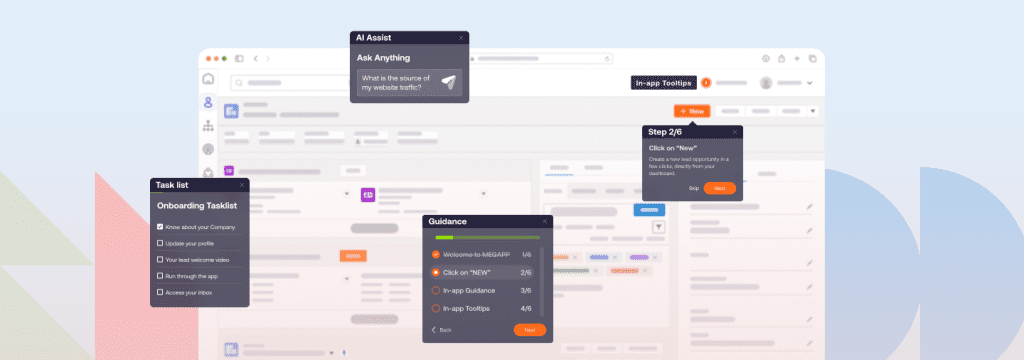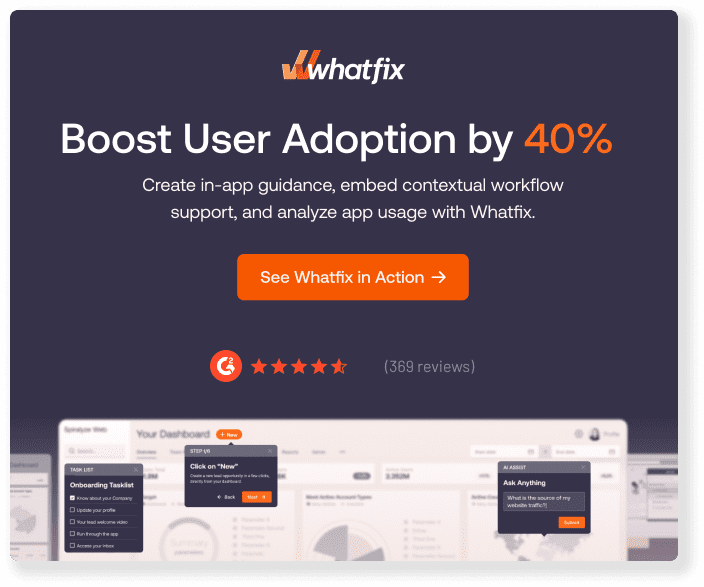Digital transformation has become a business imperative, not simply a future goal.
As markets evolve and technology reshapes how companies operate, organizations that succeed are those that approach digital transformation as a long-term, strategic initiative grounded in clear business outcomes.
But transformation doesn’t happen in a vacuum. It requires executive alignment, a flexible tech stack, process redesign, and a workforce prepared to adopt new working methods. Without technology enablement, even the most well-funded transformative initiatives fall short.
This article explores 21 real-world digital transformation case studies across banking, healthcare, retail, and manufacturing industries. Each example offers practical insight into how leading organizations modernized legacy systems, improved operational efficiency, enhanced customer experiences, and built scalable digital capabilities.
These stories highlight the importance of change management, digital adoption, and data-driven decision-making at every stage of the transformation journey. Use these examples to benchmark your own strategy, identify potential gaps, and define the next steps in your digital transformation roadmap.
21 Inspiring Examples of Digital Transformation Case Studies
Digital Transformation Examples That Show What Success Looks Like
It’s no secret that IT modernization brings many benefits, from AI-powered data insights to workflow optimization. But digital transformation is far from one-size-fits-all. Each transformation project comes with unique digital transformation challenges, and the tech landscape can look very different from sector to sector.
Some organizations have room in the budget for external assistance through a digital transformation consulting company, while others handle things in-house. No matter which approach your team is taking, it is key to understand how other companies handle the process and learn by example.
To get the ball rolling, here are inspiring digital transformation case studies to consider as you embark on a digital transformation journey in 2025:
1. Amazon extended the B2C model to embrace B2B transactions with a vision to improve the customer experience.
Amazon Business is an example of how a consumer giant transitions to the B2B space to keep up with customers’ digital expectations.
This Amazon venture is a marketplace where professionals can purchase the items they need to thrive directly from Amazon or third-party companies. Amazon Business also offers members access to analytics tools and Guided Buying, which helps individuals optimize procurement and maintain high visibility into purchasing activities.
What Changed
Amazon created an expansive marketplace for B2B vendors by offering over 250 million products ranging from cleaning supplies to industrial equipment. It also introduced customer-centric features like free two-day shipping on orders worth $49 or more and exclusive price discounts.
Technology Stack
- Purchase system integration
- Tax exemption for qualified customers and purchases
- Shared payment methods
- Order approval workflows
- Enhanced order reporting
Impact
By launching Amazon Business, it was able to tap into the B2B wholesale market, which is valued between $7.2 and $8.2 trillion in the U.S. alone. From there, it began earning revenue by charging sales commissions ranging from 6%-15% from third-party sellers, depending on the product category and the order size.
What You Can Learn
- Personalization is key for improving customer experience.
- Embrace data-driven solutions to tailor services and improve decision making.
2. Netflix transformed the entertainment industry by offering on-demand subscription-based video services to its customers.
Like the video rental company, Blockbuster, Netflix started with a pay-per-rental model. The subscription included DVD sales and rent-by-mail services. However, with rising digitalization, Netflix anticipated a change in customer demand and provided online entertainment. By getting ahead of the curve, they disrupted the entire movie rental industry, wiping out Blockbuster in the process.
What Changed
In 2007, Netflix launched a video-on-demand streaming service to supplement their DVD rental service without any additional cost to their subscriber base. It implemented a simple and scalable business model and consistently infused 10% of its budget into R&D.
Technology Stack
- On-demand streaming
- Recommendation engines
Impact
Since embracing the digital future, Netflix has become the most popular digital video content provider, leading other streaming giants such as Amazon, Hulu, and YouTube with over 85% market share. In fact, Netflix added a record 36 million subscribers directly after the start of the COVID-19 pandemic.
What You Can Learn
- Investing in customer-centric tech and initiatives can supercharge customer engagement and satisfaction.
3. Old Mutual Optimizes Financial Advisor Workflows with Whatfix
Old Mutual is a leading US financial services provider that offers a variety of insurance, investment, and wealth management solutions. Faced with internal change resistance and continuously updating technology, Old Mutual turned to Whatfix to implement a digital adoption platform and boost digital transformation initiatives.
What Changed
Old Mutual built a custom advisory ecosystem to modernize workflows for financial advisors and incorporated in-application adoption tools to support users through learning new workflows and software features.
Technology Stack
- Digital adoption platform (DAP)
- Just-in-time learning
- Contextual in-app assistant
- Self-help widgets
Impact
By enhancing user adoption, Old Mutual reduced monthly support calls by 33%. It also increased in-app success with self-help tools from 4% to 88% and aligned its digital strategy and tech stack with the needs of advisors.
What You Can Learn
- In-app support tools facilitate user adoption.
- A robust digital adoption program is the superior path to modernization success because it facilitates adoption without requiring intensive development or third-party experts.
4. Tesla uses connected car technology and over-the-air software updates to enhance customer experience, enable cost savings, and reduce carbon emissions.
Over the years, the electric vehicle (EV) manufacturer, Tesla, has truly embodied the spirit of digital transformation. As the leading EV company in the United States, Tesla operates with the core motivation of producing vehicles that exceed standards set by their gasoline-powered counterparts in both looks and performance.
What Changed
Tesla disrupted the United States auto industry by bringing vehicles directly to consumers and investing in technological innovations like electric powertrains and autonomous driving features.
Technology Stack
- Over-the-air firmware updates that remotely improve safety, performance, and infotainment capabilities.
- An autopilot feature that controls the speed and position of the car when on highways to avoid potential accidents
- Driving analytics, an intelligent data platform, and a smart autonomous driving experience.
Challenges Faced
Before Tesla entered the picture, US consumers were apprehensive about electric vehicles, let alone interacting with new driving software.
Impact
Tesla’s over-the-air updates reduce carbon emissions by saving users’ dealer visits, and these updates save consumers time and money. The company delivered a record 936,172 vehicles in 2021, an 87 % increase over the 499,550 vehicle deliveries made in 2020.
What You Can Learn
- Continuous improvement and innovation are critical for digital transformation success.
- With the right messaging and high-quality offerings, it is possible to turn the tide on consumer sentiment.
5. Glassdoor revolutionized the recruitment industry by allowing employees to make informed decisions.
Glassdoor is an online tool focused on increasing transparency in the workplace and helping people find the right job through public peer-to-peer reviews on employers, including overall company culture, benefits, and salaries.
What Changed
Glassdoor empowered job seekers to shift away from relying on word-of-mouth for company insights and toward tapping into a wealth of publicly shared experiences. It also allowed recruiting agencies to publish company data on profiles to attract talent and help job seekers make more educated application decisions.
Technology Stack
- An innovative peer-to-peer network for job searchers
- An extensive pool of interview questions
- Shared salary insights, CEO ratings, and organizational culture reviews
Impact
Glassdoor leverages its data collection for labor market research in the US. Its portfolio of Fortune’s “Best Companies to Work For” companies outperformed the S&P 500 by 84.2%, while the “Best Places to Work” portfolio outperformed the overall market by 115.6%.
6. Under Armour diversified from an athletic apparel company to a new data-driven digital business stream to transform the fitness industry.
The American sportswear company Under Armour introduced the concept of “Connected Fitness” by providing a platform to track, analyze, and share personal health data directly on its customers’ phones.
What Changed
Under Armour acquired several technology-based fitness organizations, such as MapMyFitness, MyFitnessPal, and European fitness app Endomondo, for a combined $715 million to obtain the required technology and extensive customer database to get its fitness app up and running.
Under Armour merged its physical and digital offerings to provide an immersive customer experience via products like Armourbox. The company urged its customers to go online and share their training schedule, favorite shoe style, and fitness goals. It used advanced analytics to send customers new shoes or apparel on a subscription basis, offering customers a greater value over their lifetime.
Technology Stack
- The Connected Fitness app feeds information to Under Armour, identifying fitness and health trends and providing users with the data they’re most interested in.
- SAP HANA ERP: helped Under Armour move to an agile development model and data center footprint.
- Dell Enterprise MC
- Dell EMC’s Data Protection and Dell Technologies fuel digital innovation and generate powerful data insights.
Impact
Ultimately, these digital modernization efforts helped Under Armour provide customers with a tailored experience and create a digital brand with a strong consumer focus, agility, and change culture.
What You Can Learn
- Data collection can benefit both companies and their customers
7. Internet Brands® subsidiary Baystone Media leverages Whatfix DAP to drive product adoption of its healthcare businesses.
Baystone Media provides end-to-end marketing solutions for healthcare companies by offering a low-cost, high-value subscription to Internet Brands® to promote their practices digitally. Baystone Media empowers its customers by offering codeless personal website creation.
What Changed
The idea was to implement a solution for Baystone Media and its sister companies to enable clients to navigate its platforms easily. In addition to PDFs and specific training videos, the search was on for a real-time interactive walkthrough solution, culminating with Whatfix.
Technology Stack
- Whatfix DAP
- Interactive Walkthroughs
- Video training content
Challenges Faced
Baystone has a less tech-inclined user base, making it difficult for customers to engage with their services.
Impact
Baystone Media saw a 10% decrease in inbound calls and a 4.17% decrease in support tickets, giving them the runway to spend more time enhancing their client service.
What You Can Learn
- Use technology to cater to customer needs and encourage sales.
- Drive user adoption with a DAP like Whatfix.
8. Sophos implemented Salesforce to streamline its business and manage customer relations more effectively.
The cybersecurity platform, Sophos, used Whatfix DAP to facilitate user adoption for Salesforce and improve business operations.
What Changed
Sophos went live with Salesforce to accelerate its sales process, enhance sales productivity, and increase the number of accounts won. To improve user adoption, Sophos implemented Whatfix to provide interactive, on-demand training that helped users learn in the flow of work. The 24/7 availability of on-demand self-support, contextual guidance, and smart tips allowed Sophos to manage its new CRM implementation effectively.
With Whatfix’s in-app content like interactive walkthroughs and pop-ups, Sophos was able to unify internal communications.
Technology Stack
- Salesforce CRM
- Whatfix DAP
Challenges Faced
After implementing Salesforce, users had a difficult time navigating its complex interface and frequent updates, resulting in a decreased ROI. The solution? Whatfix DAP.
Impact
After Sophos incorporated Whatfix into its Salesforce adoption strategy, the organization saw a massive reduction in sales operations support tickets globally: 15% (~12,000 tickets). It also saved 1070 hours and achieved an ROI of 342%.
What You Can Learn
- Strengthen your user adoption strategy with a digital adoption platform.
9. Michelin Solutions uses IoT & AI to provide customers with a more holistic mobility experience.
Michelin, a leader in tire manufacturing, has evolved over the years, transforming into a multifaceted company that provides services and solutions for commercial fleet operations.
What Changed
The digital strategy of Michelin Solutions has essentially centered around three priorities:
- Creating a personalized relationship with customers and end-users
- Developing new business models
- Improving their existing business processes
Technology Stack
- AI for R&D
- A digital supply chain driven through digital manufacturing and predictive maintenance.
- Robots that handle clerical tasks
- Advanced analytics to leverage huge data pools and provide customers with insights.
Impact
Through its focus on continual digital improvement, Michelin Solutions secured cost savings and improved efficiency for Effifuel and Effitires, doubling per-vehicle profits with Effifuel.
It also reduced consumption by 2.5 L per 100km, translating into annual savings of €3,200 for long-haul transport (at least 2.1% reduction in the total cost of ownership & 8 tonnes in CO2 emissions).
In the end, Michelin Solutions shifted its business model from selling tires to a service guaranteeing performance, helping it achieve higher customer satisfaction, increased loyalty, and raised EBITDA margins.
What You Can Learn
- Testing matters: Michelin Solutions carefully enforced cultural change and launched small pilots before the change implementation.
10. IKEA CX + AR/VR + Logistics
The global furniture company IKEA has become a leader in digital transformation for retail. Though IKEA has been around for decades, it continues to grow and adapt in the digital age. In fact, between 2020 and 2023, IKEA tripled its e-commerce levels and transformed its stores into fulfillment centers.
What Changed
Leaning into its customer-centric, fun approach to selling furniture, IKEA created the IKEA Place App for mobile. This tool uses AR and VR to allow customers to experience what a piece of IKEA furniture would look like in their home and ensure it fits before making a purchase decision.
IKEA has also digitally transformed other aspects of the shopping experience for consumers with self-service kiosks, digital catalogs, interactive showrooms, and general investments in e-commerce.
Technology Stack
- IKEA Place App
- Self Service Kiosks
- Unified shopping experiences
- Personalized product recommendations
Impact
IKEA’s continued growth is a testament to its successful digital transformation efforts. Its IKEA Place App has been downloaded more than 8 million times and provided customers with 98% accuracy in product scale and dimensions. Over time, IKEA has discovered that about 40% of consumers will actually pay higher prices for products they can view with AR ahead of time, and its app users are 11% more likely to complete a purchase than other customers.
What You Can Learn
- Digital transformation can and should touch every corner of your organization
- Improving the buying experience with digital tools can help customers make better purchase decisions.
11. Microsoft Culture, Remote Work, Platformization
Microsoft is a massive technology corporation that leads the way in its software and services offerings, especially for businesses. Over the years, the company has undergone its own digital transformation, embracing AI and focusing on optimizing the digital employee experience.
What Changed
Since 1985, Microsoft has undergone a long and winding journey toward modern engineering and AI innovation. In addition to tech development, the organization has undergone a cultural transformation that replaced a focus on individual excellence with continuous improvement.
Technology Stack
- Azure Cloud
- Microsoft 365 Copilot for employee productivity management
- AI integration across operations
- Microsoft Viva for workforce engagement and performance
- Microsoft Digital internal IT organization
Impact
Microsoft’s focus on vision and user experience allowed it to adapt through challenging market periods, and seismic shifts in how employees get their work done. The organization continues to develop and improve its technological infrastructure, creating solutions that help businesses adapt to evolving digital capabilities, physical space needs, and cultural norms. The company demonstrates its confidence in its own products and services by becoming “Customer Zero” for many of its own initiatives.
What You Can Learn
- Develop products and services that your team is proud and excited about using.
- Evolve culture along with technology.
12: Nike’s Direct-to-consumer transformation
Over the years, the athletic goods giant Nike has made substantial investments in tech and IT solutions to manage its e-commerce and supply chain operations.
What Changed
Over the past decade, Nike has been building its digital infrastructure, developing DTC sales channels and consumer mobile apps that contribute to a member-centric business model. By the time the COVID-19 pandemic hit, the organization was poised to thrive in a digital-first retail environment.
Technology Stack
- Nike Digital DTC sales channels
- Nike Mobile app
- Nike Training Club and Nike Run Club
- Personalized marketing
Impact
As of 2022, Nike Digital accounted for 26% of the company’s revenue. The company’s shift from wholesale accounts to digital DTC sales has helped it ensure consistent revenue growth and improve relationships with its remaining wholesale partners.
What You Can Learn
- Lean heavily on market research and stay ahead of the curve.
- Shifting to a digital DTC sales model can be a winning move.
13. Domino’s Improves Customer Experience with Digital-First Ordering
The leading pizza delivery chain, Domino’s, operates with a digitally oriented philosophy. Since 2007, it has allowed customers to order pizzas online.
What Changed
Domino’s took a customer-centric approach to digital transformation by implementing groundbreaking online ordering tools with engaging features like Domino’s Tracker® and Pizza Builder. It also released dedicated ordering apps for phones and tablets, as well as AnyWare technology that lets customers order by text or even Amazon Alexa.
Technology Stack
- Digital ordering and order tracking
- Online customer loyalty program
- PinPoint Delivery
- AnyWare Ordering
Impact
Since the early 2000s, Domino’s has been on a journey of improvement and digital transformation that is mainly responsible for the company’s continued success. This transformation has been holistic. In fact, Domino’s Chief Digital Officer, Dennis Maloney, has said, “We transitioned from being a pizza company to a tech company that happens to make pizza.”Today, more than 85% of Domino’s sales are made via digital channels.
What You Can Learn
- Follow the market and cater directly to consumer needs.
- Always strive for improvement, even if it requires making big changes.
14. Chevron: Operational Digitization & workforce tools in field ops
Chevron is an American multinational energy corporation, specializing in oil and gas. This company has been a long-time proponent of digitalization and continues to engage in digital transformation.
What Changed
Chevron has created virtual replicas, called digital twins, of some of its gas plants and other facilities to identify and predict real-world process issues before they can have any real-world impact. It also implemented tools using Industrial AI and virtual reality for improved predictive maintenance and real-time problem resolution.
Technology Stack
- Industrial AI for predictive maintenance and process automation
- Microsoft HoloLens for virtual issue resolution
- Digital Twins improve problem-solving with realistic predictions
- Digital Scholar Program sends high-performing employees to MIT and Rice University to earn relevant Master’s degrees
Impact
Through digital transformation, Chevron has implemented various digital tools to improve its field operations and make facilities safer for employees. These efforts have contributed to a culture of innovation and helped Chevron invest in its own future by empowering its employees to pursue graduate degrees in relevant fields.
What You Can Learn
- Don’t invest in technology just for the sake of it. Digital modernization needs to serve a specific business purpose, or many.
- Adaptability is vital to staying afloat in evolving business climates.
15. Novartis: Data-first approach to R&D and employee systems
Swiss pharmaceutical company, Novartis, used digital transformation to overhaul its research and development (R&D) efforts.
What Changed
Novartis implemented AI- and ML-powered solutions for data analytics, supply chain management, and operations improvement. This pharmaceutical company also implemented a wide-spanning digital transformation project to develop a patient-centric business strategy.
Technology Stack
- IBM Watson uses machine learning to analyze medical literature and trial outcomes
- Blockchain for supply chain transparency
- Robotic Process Automation (RPA) for streamlining HR and finance operations
Challenges Faced
Before digital transformation, Novartis faced sluggish drug development pipelines, internal siloes, and serious compliance risks.
Impact
After these changes, Novartis was able to identify viable drug candidates 30-40% faster, improve trial success rates, improve healthcare provider loyalty through digital education, increase supply chain transparency, and improve patient outcomes.
What You Can Learn
- A scalable, integrated technology ecosystem is essential for enterprise-level transformation.
- Digital transformation should be an ongoing journey.
16. HSBC: Core banking system overhaul + employee tech enablement
The large bank and financial services group, HSBC, serves hundreds of thousands of customers every year. This bank embarked on a digital transformation journey with Highspot, an AI-powered sales platform. It also teamed up with Accenture to overhaul its HR strategy by implementing a wealth of digital HR management tools.
What Changed
HSBC developed a digital approach to sales and client services. It implemented HSBC as its core sales enablement solution and revamped its HR tech stack by investing in several digital software solutions.
Technology Stack
- Highspot for Sales Enablement
- SAP for Enterprise Resource Planning
- ServiceNow cloud computing for automated business workflows
- MuleSoft for integration and API management
Impact
As a result, HSBC’s sales system sees over 15,000 unique interactions every month, and leaders have noted increased engagement and collaboration across the organization. The organization has also been able to improve shareholder returns and employee experience.
HSBC’s Global Head of Client Development, James Bickerton, has said that implementing this system has provided the bank with “a fresh, exciting experience for our employees and has led to a community around content.”
What You Can Learn
- Tackle digital transformation from all different angles.
- Bring in expert consultants for very large digital transformation projects
17. Mayo Clinic: EHR integration and remote patient monitoring
Mayo Clinic, a private, US-based medical center known globally for innovation and excellence, implemented a massive electronic health record project to improve patient experience and integrate health records across 90 hospitals and clinics.
What Changed
Mayo Clinic invested over $1.5 billion to link records across every Mayo location with Epic’s centralized Electronic Health Record (EHR) system. It also overhauled its revenue cycle management system to facilitate the billing process.
Technology Stack
- Epic Electronic Health Record system (EHR): A centralized system streamlines and improves information management, ensuring that professionals across Mayo Clinic campuses can easily access accurate patient records.
- Interactive Self-Service Kiosks: Interactive machines allow patients to easily check in, verify, and update information.
Challenges Faced
The Mayo health system spans over 90 hospitals and clinics, making this EHR project an immense undertaking. Mayo Clinic’s CIO, Cris Ross, noted the high number of specialties and subspecialties involved in the rollout.
Impact
By centralizing health record management into a single platform, Mayo Clinic has been able to speed up workflows, eliminate redundancies, and empower healthcare professionals to keep focus on their patients. Mayo Clinic also improved patient experience by providing self-service machines in Minnesota and Wisconsin clinics.
What You Can Learn
- Use case studies to learn how other organizations overcame digital transformation challenges.
- Build dedicated transformation teams: Mayo’s core project team is made up of over 460 team members.
18. CarMax: Omnichannel car buying experience, employee-led CX
Popular used car retailer, CarMax, is leading the charge when it comes to digital transformation in the automotive sector. This company uses machine learning and analytics to combine human insight and tech to deliver customer-focused services.
What Changed
CarMax has adopted an omnichannel strategy as a core part of its business model. This strategy blends the online and in-person car-buying process, providing customers with optimized listings, targeted content, and an overall more efficient experience.
Technology Stack
- Customer Relationship Management (CRM): CarMax built a customized CRM that unifies information gathered from their online and in-store visits.
- AI and Machine Learning help CarMax deliver curated car recommendations.
Impact
- CarMax generates 50 million car recommendations per day
- CarMax’s omnichannel strategy helped it increase retail used unit sales by 5.4% and wholesale unit sales by 6.3% in 2024.
What You Can Learn
- Keep things customer-centric: Carmax’s VP of product, Brian Ennis, advises companies to “think like a startup and always prepare for change, with customers in the center.”
- Take a test-and-learn approach to keep your business agile.
19. Unilever: Unified global HR systems, rollout of a digital workplace experience
Leading consumer goods company, Unilever, unified its HR systems by implementing Workday HCM. This company has an expansive digital infrastructure, handling over 3 billion transactions per week, making continual digital transformation a vital, but complex endeavor.
What Changed
To align its HR operations with growth objectives, Unilever teamed up with Berkeley to implement a new HR IT strategy that modernized its core HR platform and improved the functionality of its L&D software.
Technology Stack
- Workday HCM: A centralized cloud-based HR operations management platform. This tool empowered Unilever to facilitate HR process configuration, create mobile self-service options for busy employees, and leverage performance data for continuous innovation and improvement.
Impact
Unilever standardized global HR processes to streamline people management for over 174,000 employees across 90 countries.
What You Can Learn
- If you have the resources, take advantage of a consultant who delivers expertise while honoring internal knowledge.
20. Procter & Gamble (P&G): leveraged digital twins and advanced analytics to optimize manufacturing, supply chain, and workforce operations
Procter & Gamble (P&G), a long-time leader in consumer goods, leverages modern digital solutions to maintain its status as an industry leader. In a Forbes interview, P&G’s CIO, Seth Cohen, described P&G’s approach to digital transformation as a “maniacal focus on understanding the wants and needs of the consumer.”
What Changed
Through its massive investments in digital transformation projects ($1.1 billion on information and communication technology (ICT) in 2024), P&G has become a leader in “smart manufacturing,” using IoT for touchless control of production operations. P&G also prioritizes company-wide digital upskilling and developing tech-forward agile supply chain management practices.
This has allowed for real-time oversight of production lines and resource uses that have streamlined operations and eliminated inefficiencies. This means P&G’s focus on digital transformation has not only been good for profit margins, but the environment as well.
Technology Stack
- Industrial IoT (IIoT): Smart sensors and other devices that allow employees to make real-time improvements to processes and workspace conditions.
- Digital twins: Digital replicas of factories, machines, and products allow P&G leaders to enhance automation in manufacturing and plan new workflows and machinery updates without risking impact to live operations.
- AI and machine learning: This organization uses AI across processes to amplify productivity and improve employee experience.
- Microsoft Cloud: P&G partnered with Microsoft to develop manufacturing software that collects and analyzes manufacturing data from over 100 locations, incorporates machine learning models to predict production volumes, and supports supply chain operations.
Impact
This multinational organization has maintained its position as a leader in manufacturing everyday goods through a substantial investment in process optimization and digital transformation. P&G even created a Digital Enablement Office (DEO), which incubates ideas around manufacturing and packaging processes for company-wide implementation. By using modern, digital approaches to improve all internal operations, P&G stays agile and continues to excel.
What You Can Learn
- Prioritizing innovation and constructive disruption drives progress and helps shape entire industries.
- Focus on performance improvement and value creation over digitization for its own sake.
- Start with the basics. Before investing in shiny new tech, manufacturers must have a solid foundation of high-performing machinery and optimized operational processes.
21. Walmart: Deployed new digital tools to optimize experiences for retail workers and customers
Walmart maintained its competitive advantage as e-commerce rose to prominence by developing a dedicated e-commerce Division. This team focused on creating an online shopping experience that aligned with its already successful in-person one. Walmart’s continuous focus on digital transformation has helped the massive company remain a world retail leader in the face of changes through evolving consumer demographics, habits, and expectations.
What Changed
Over the years, Walmart has continually expanded its digital footprint by creating leading apps for shoppers that utilize geofencing, personalized recommendations, and online-order, in-person pickup tools. By developing proprietary digital retail technology and prioritizing e-commerce, Walmart leaders have been able to focus on mobile-first enablement and operations digitization at scale.
The Technology Stack
- Shopycat: Walmart’s social gift finder that uses big data and social media to suggest gifts for customers to purchase.
- Walmart Element: A Walmart-specific resource management tool that uses machine learning to evaluate and optimize sales channels and supply chain management.
- Polaris Search Engine: Another proprietary technology, this search engine employs semantic research technology to improve search results.
The Impact
As of 2024, Walmart is the second-largest online retail company in the United States, amassing over $161 billion per quarter, second only to Amazon, another giant in the retail industry.
Walmart’s dedication to digital transformation has also led to groundbreaking innovation. Walmart’s e-commerce division has created an internal digital incubator, WalmartLabs, which has developed next-generation digital solutions to improve Walmart’s search engines, mobile applications, supply chain management, cloud computing, and data analytics.
What You Can Learn
- With the right resources, a willingness and ability to adapt to evolving customer expectations is invaluable.
- Approach digital transformation from multiple angles. Focusing on improving customer experience can lead to internal innovations later on.
- Adaptability is key to staying afloat. Walmart took notice as the retail world shifted to the digital space and began investing promptly to ensure that the organization could evolve along with the retail industry and its customer base.
Personalize Your Digital Transformation Solutions with Whatfix
Digital transformation doesn’t end with a software rollout. Most friction emerges across the application lifecycle—during user acceptance testing, onboarding, change management, and beyond. These friction points slow down ROI, create resistance, and inflate support costs. Whatfix helps enterprises navigate these stages seamlessly to maximize the value of their transformation investments.
Here’s how Whatfix supports each phase of the journey:
- User Acceptance Testing (UAT): With Whatfix Mirror, teams can build realistic test environments that simulate live applications—no risk to production data, no delays in feedback collection. This helps accelerate UAT cycles and ensures real-user scenarios are tested thoroughly.
- User Onboarding: Whatfix DAP delivers personalized, in-app walkthroughs and checklists that guide users through new tools from day one—shortening time-to-productivity and reducing training overhead.
- Change Management: Whatfix enables proactive change communication with pop-ups, tooltips, and beacons directly inside your applications. It helps you drive awareness and adoption of updates without relying on scattered emails or town halls.
- Embedded Performance Support: Employees can access help content, step-by-step guidance, and knowledge base articles directly within the flow of work—eliminating context switching and improving task completion rates.
- Process Governance: Whatfix Analytics tracks how users interact with digital workflows, helping leaders identify deviations, inefficiencies, and compliance gaps. This visibility supports continuous process improvement.
- New and Advanced Feature Adoption: New feature launches often fly under the radar. With Whatfix, you can promote advanced capabilities with targeted nudges and tutorials based on user roles and behavior.
- Task Optimization: By analyzing real user journeys, Whatfix helps identify where users drop off or struggle—so you can simplify workflows and drive better outcomes.
Whatfix bridges the gap between software and user success—empowering teams to realize the full ROI of their digital transformation strategies. Ready to see how? Schedule a demo with our experts today. Schedule a demo with our experts today.








